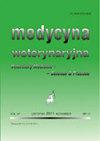异食癖(异食癖)水牛犊牛血清矿物质水平及血液生化指标
IF 0.4
4区 农林科学
Q4 VETERINARY SCIENCES
Medycyna Weterynaryjna-Veterinary Medicine-Science and Practice
Pub Date : 2023-01-01
DOI:10.21521/mw.6753
引用次数: 0
摘要
异食癖被定义为以舔食非营养物质为特征的食欲减退或异常。本研究的目的是报道患有异食癖的水牛犊牛血清矿物质水平和血液生化参数的变化。该研究包括30头表现出异食癖行为的水牛,比如舔马厩墙壁或吃羊毛和非食物(异食癖组),以及6头没有异食癖行为迹象的水牛(对照组)。两组患儿年龄在1 ~ 6个月之间。异食癖组血液学的分析揭示了血红细胞减少(P < 0.001),红细胞分布宽度(P < 0.05)以及增加平均微粒体积和平均微粒血红蛋白(P < 0.001),而生化参数以天冬氨酸转氨酶增加(P < 0.01),丙氨酸转氨酶(P < 0.001)和乳酸脱氢酶(P < 0.05)水平,降低肌酐和葡萄糖(P < 0.01)水平。异食癖组血清锰、铁、锌、硒(P < 0.001)和铜(P < 0.01)浓度显著降低。综上所述,血清铁、铜、锌、锰和硒水平的缺乏在水牛犊牛异食癖的病因中起重要作用。本文章由计算机程序翻译,如有差异,请以英文原文为准。
Serum Mineral Levels and Haematobiochemical Parameters in Buffalo Calves with Allotriophagy (Pica Syndrome)
Pica is defined as a depraved or abnormal appetite characterized by licking and eating non-nutritive substances. The aim of this study was to report changes in the serum mineral levels and haematobiochemical parameters of buffalo calves with pica. The study included 30 buffalo calves exhibiting pica behaviour, such as licking stall walls or eating wool and non-food items (pica group), and 6 buffalo calves without the signs of pica behaviour (control group). The age of both groups ranged between 1 and 6 months. In the pica group, the haematological analysis revealed a decrease in red blood cells (P < 0.001) and red cell distribution width (P < 0.05) as well as an increase in the mean corpuscular volume and mean corpuscular haemoglobin (P < 0.001), whereas the biochemical parameters were characterized by an increase in aspartate aminotransferase (P < 0.01), alanine aminotransferase (P < 0.001) and lactate dehydrogenase (P < 0.05) levels and a decrease in creatinine and glucose (P < 0.01) levels. Furthermore, the pica group showed a significant decrease in serum manganese, iron, zinc, selenium (P < 0.001) and copper (P < 0.01) concentrations. In conclusion, it was determined that deficiencies in the levels of serum iron, copper, zinc, manganese and selenium play an important role in the aetiology of pica in buffalo calves.
求助全文
通过发布文献求助,成功后即可免费获取论文全文。
去求助
来源期刊

Medycyna Weterynaryjna-Veterinary Medicine-Science and Practice
VETERINARY SCIENCES-
CiteScore
0.80
自引率
0.00%
发文量
73
审稿时长
4-8 weeks
期刊介绍:
"Medycyna Weterynaryjna" publishes various types of articles which are grouped in the following editorial categories: reviews, original studies, scientific and professional problems, the history of veterinary medicine, posthumous memoirs, as well as chronicles that briefly relate scientific advances and developments in the veterinary profession and medicine. The most important are the first two categories, which are published with short summaries in English. Moreover, from 2001 the editors of "Medycyna Weterynaryjna", bearing in mind market demands, has also started publishing entire works in English. Since 2008 the periodical has appeared in an electronic version. The following are available in this version: summaries of studies published from 1999 to 2005, full versions of all the studies published in the years 2006-2011 (in pdf files), and full versions of the English studies published in the current year (pdf). Only summaries of the remaining studies from the current year are available. In accordance with the principles accepted by the editors, the full versions of these texts will not be made available until next year.
All articles are evaluated twice by leading Polish scientists and professionals before they are considered for publication. For years now "Medycyna Weterynaryjna" has maintained a high standard thanks to this system. The review articles are actually succinct monographs dealing with specific scientific and professional problems that are based on the most recent findings. Original works have a particular value, since they present research carried out in Polish and international scientific centers.
 求助内容:
求助内容: 应助结果提醒方式:
应助结果提醒方式:


